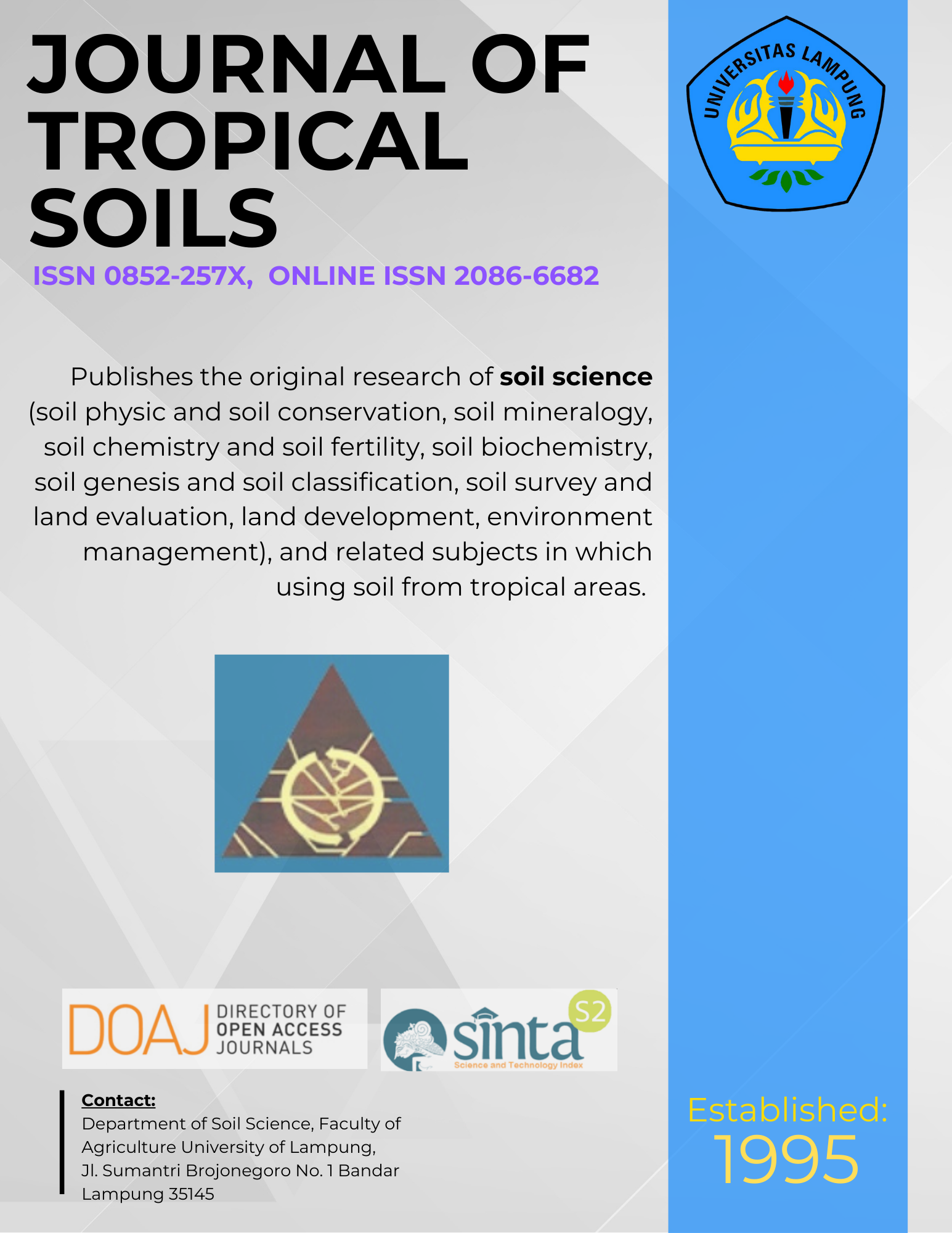Artikel (56)
Indonesian is huge areas that have the highest precipitation in the world, therefore water deficit of groundwater is  often happened at anywhere. This study was related to determination of recharge area with approached by combining geological setting, stable isotopes and chemictry content of ...
JOURNAL OF TROPICAL SOILS; Vol. 16 No. 3: September 2011; 245-256 | 2019
The objective of the study was to develop the water management operational plan at tertiary blocks for the growth of rice and corn. Study was conducted at reclaimed tidal lowland area which was located at Primer 10, Delta Saleh. This area was classified as a C-typhology land (dry). The m...
JOURNAL OF TROPICAL SOILS; Vol. 16 No. 3: September 2011; 233-244 | 2019
Soil microbes, such as arbuscular mycorrhizal fungi (AMF) have the ability to dissolve unavailable phosphorus (P) and they can be used as an indicator of the P availability in soil. The study was conducted on upland soil in East Java. The soil was sampled twice, before and after planting...
JOURNAL OF TROPICAL SOILS; Vol. 16 No. 3: September 2011; 225-232 | 2019
Degraded soils at mine sites are often associated with decreased soil fertility. However, soil nutrient status might be improved through biomass recovery primarily from re-vegetation. This paper relates nutrient cycling index (NCI) derived from Landscape Function Analysis (LFA) to soil respi...
JOURNAL OF TROPICAL SOILS; Vol. 16 No. 3: September 2011; 219-223 | 2019
Crop salt tolerance is generally assessed as the relative yield response to the increasing of root zone salinity. This paper studied the maize tolerance under salinine water (ECw) and their relationship with the changes of soil chemistry characteristics, crop growth and yield of maize. T...
JOURNAL OF TROPICAL SOILS; Vol. 16 No. 3: September 2011; 211-218 | 2019
In the past, most rice study was carried out in irrigated lowland rice and less or no attention was paid to the terraced paddy field system. Study on seasonal rice biomass production and nutrient uptake variation of IR-64 variety cultivated in terraced paddy field system was carried out in Keji Vill...
JOURNAL OF TROPICAL SOILS; Vol. 16 No. 3: September 2011; 201-210 | 2019
The effectiveness of Commercial Biofertilizer 1 (CBF1) on the growth and yield of caisim (Brassica sp.) was examined in the greenhouse of Indonesian Soil Research Institute in Bogor. The completely randomized design (CRD) was performed to examine the effects of Commercial Biofertilizer 1 (CBF1) on F...
JOURNAL OF TROPICAL SOILS; Vol. 16 No. 3: September 2011; 191-199 | 2019
Humic substance (HS) extracted from composted agricultural waste contains organic acids that potential for an acid soil amandement. Functional group of COOH and OH in synthetically organic acid is higher than in HS originated from composted agricultural waste. Addition of synthetically organic acid ...
JOURNAL OF TROPICAL SOILS; Vol. 16 No. 3: September 2011; 183-190 | 2019
Characterization of Various Kinds, Thickness and Bentonite Sand Ratio as Hardplain Materials: a Basic Concept for Coastal Sandy Land Management (Saparso, Tohari, D. Shiddieq, and B. Setiadi): Coastal sandy land development faces the sand characteristics, the lower holding water capacity and ...
JOURNAL OF TROPICAL SOILS; Vol. 14 No. 2: May 2009; 167-176 | 2019
Nature on Soil Phisical, Chemical and Ftir Spectrophotometry of Hydrophobic Peat From Central Kalimantan (S.N.H. Utami, A. Maas, B. Radjagukguk, and B.H. Purwanto): Peat soils naturally have hydrophilic or water-loving character with highly capable of exchanging the cations and cycling the nutrients...
JOURNAL OF TROPICAL SOILS; Vol. 14 No. 2: May 2009; 159-166 | 2019


